AMD Delivers Crimson ReLive Drivers: Yearly Feature Update for Radeon Gamers and Professionals
by Ian Cutress on December 8, 2016 9:00 AM ESTCrimson ReLive: Radeon Pro Drivers
The rebrand of the FirePro line of professional GPUs to Radeon Pro has been, as probably expected by the professional environment, a slow and steady trek. Over the past couple of years, a number of initiatives from AMD to integrate professional style workflows into something that can be optimized under AMD have been in place. As a result AMD is making the launch of this next generation package a marked uptick for an increased level of platform testing, ISV certification, and more stress testing under professional level requirements.
This extends to performance as well, particularly on popular software on both older FirePro and the new Radeon Pro cards.
With the ReLive update, AMD is committing to Enterprise users (data centers, HPC, large clients) that there will be a regular cadence of driver updates throughout 2017, with the 4th Thursday of each quarter (so 1/26, 4/27, 7/27 and 10/26) marked for official releases.
The Radeon Pro drivers and the regular drivers, despite still being separate packages, are set to integrate more common features between them during 2017. This includes game engine support, allowing professional workflows to take advantage of DX12 for CAD visualization or modeling in Unity with professional cards. LiquidVR will also come to the Pro driver set for specific cards (WX7100, Pro Duo, W9100), enabling VR workflows for a number of ISV packages as shown below.
The Radeon Pro driver for Linux is also being improved with AMD offering an both open source driver core as well as a proprietary driver set. The latter was explained as specifically pointing to larger install/professional bases that might have additional IP requirements to which an open-source implementation might not be sufficient. Nonetheless, this means FreeSync 1.0 on Linux, improved performance for Pro WX and FirePro W cards under Ubuntu, RedHat and CentOS.
The launch of ReLive for Radeon Pro will also include support for vmware vSphere 6.5, allowing direct GPU virtualization for FirePro S7100X/S7150/S7150 X2 cards and deterministic performance across multiple VMs. AMD is keen to stress that there are no licensing fees for this and these drivers in virtualized environments also come with a number of high-priority ISV certifications that a number of customers demand.


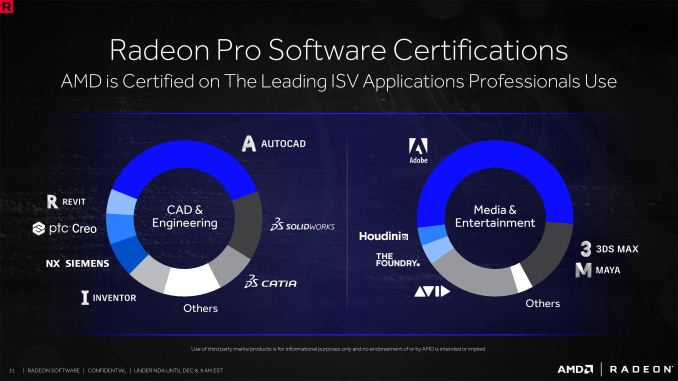
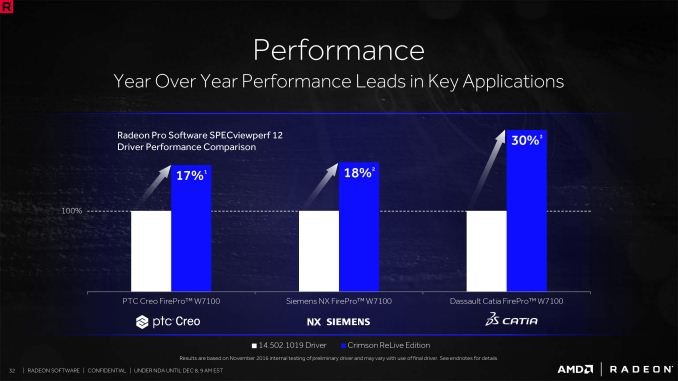
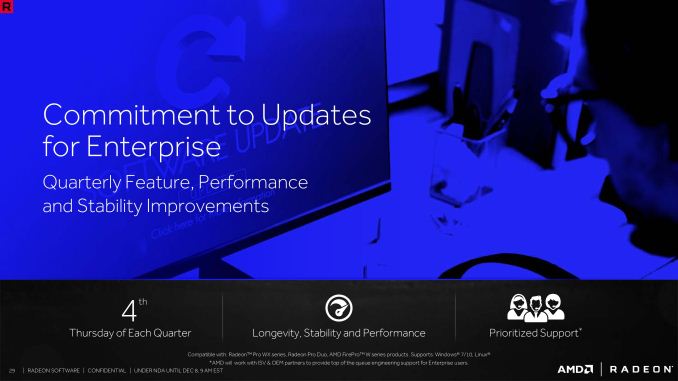
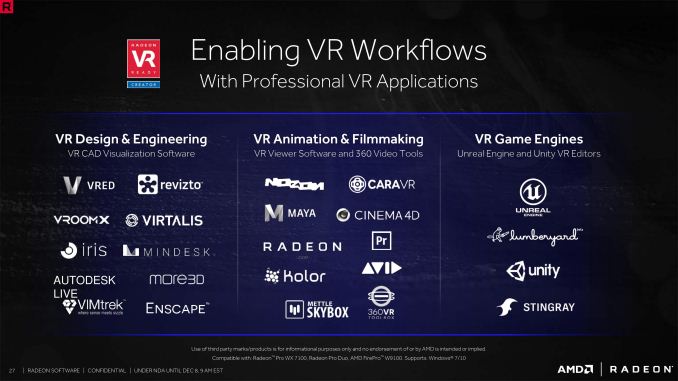
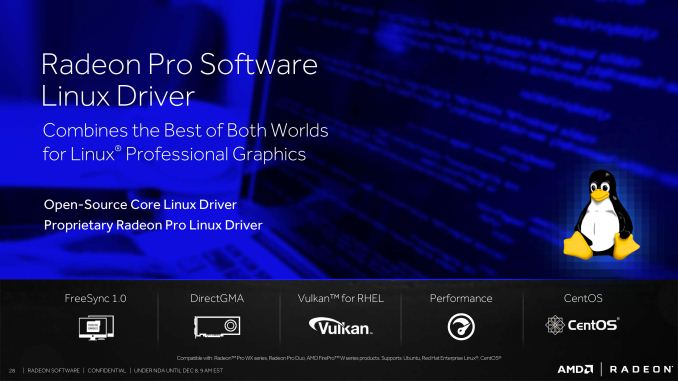









48 Comments
View All Comments
PseudoKnight - Thursday, December 8, 2016 - link
"took a few seconds..." cracked me uplol, now i'm imagining you starting up your download manager just in case your sister makes a phone call and you have to resume the download later.
A5 - Thursday, December 8, 2016 - link
It's possible the board designs spec a different HDMI/DP chip that supports it or something.Probably just a testing or marketing thing though.
Colin1497 - Thursday, December 8, 2016 - link
Yeah, I have a box with a 285 in it (my son's). Doesn't have an appropriate monitor today, but the monitor is the next thing to get replaced, so it was personal interest driving the Q. :)Manch - Thursday, December 8, 2016 - link
Was wondering the same thing. Why the rebadge only. Ill start the download :D as soon as I get home. Then I'm requesting the feature for my 290X'snathanddrews - Thursday, December 8, 2016 - link
The only differences over Hawaii that I know of are that Grenada has refined power delivery, power management, and faster 6 GHz VRAM. Pretty sure that Grenada and Hawaii share the same encode/decode blocks and display outputs, but it's possible that Grenada shipped with higher speed DisplayPort ports and it was never published due to the lack of concrete validation methodology at the time, but I doubt it. Pretty sure AMD/NVIDIA just buy DP/HDMI port hardware/controllers in bulk and order whatever is available at the time.Technically, HDR10 metadata can be streamed using older display connections (just like Dolby Vision), but without monitor/TV support, I'm curious to what AMD has planned. My guess is HDR10 will be limited to 8-bit Rec.709 on Grenada, whereas Polaris will get support for HDR10 10-bit Rec.2020, based upon port capabilities alone.
Why TongaXT is included in the mix and not Hawaii, I don't know.
testbug00 - Sunday, December 11, 2016 - link
Tonga is GCN gen3, Hawaii is GCN gen2.Gen1=Cape Verde, Pitcairn, Tahiti.
Gen2= Bonaire, Hawaii
Gen3= tonga, Fiji
Gen4= P11, P11
There is orland and I think one more 28nm GPU, but I do not know if they are gen 1, 2 or 3z
R3MF - Thursday, December 8, 2016 - link
"On the HDR front, AMD has been promoting that high end R9-300 series"What is it about a 390 series card that is absent in the 290 series card, to make the former compliant with HDR when the latter is not?
Is this purely HDR10 support, or does it include Dolby Vision as EA have said Mass Effect Andromeda will use on the PC? If not, do AMD think this matters?
ET - Thursday, December 8, 2016 - link
Hardware compatibility looks incomplete. It makes no sense for example that user feedback isn't available on APU's, or that VP9 4K60 works on discrete and Stoney Ridge but not on Bristol Ridge.R3MF - Thursday, December 8, 2016 - link
Re: Linux supportDoes "SLED/SLES 12" support indicate there will be a driver compatible with Opensuse Leap 42.2?
PseudoKnight - Thursday, December 8, 2016 - link
I really appreciate AMD adding features and improvements to even their five year old cards (own a 3 year old card). I've also liked this new direction they've been taking with their software since Crimson. It never felt quite finished (with some things being tacked on) but this looks like it might finally rounds things out. I'm particularly looking forward to testing out ReLive DVR. I suspect I'll stick with OBS Studio, but here's hoping it surprises me.